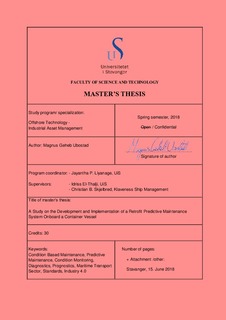| dc.description.abstract | As industry 4.0 have gained momentum, a maintenance approach first introduced in the 1960’s has been reborn into the age of connectivity. Previously constrained from showing its true potential by limitations in technology, Condition Based Maintenance is finally ready to deliver long promised benefits and be adopted in large scale by industries worldwide. The philosophy behind the maintenance approach is to predict failure before it happens by monitoring the condition of an asset, and by this makes it possible to act in advance. Global technology trends such as Internet of Things, big data and machine learning are some of the main drivers supporting and realizing the vision of Condition Based Maintenance in the fourth industrial revolution that we have just entered. In combination with cheaper and better sensors, processing power and connectivity, Condition Based Maintenance sets out to be one of the corner stones in enabling intelligent and smart maintenance.
While the onshore industry has realized the benefits and have been exploring how to reap the fruits of Condition Based Maintenance in relation to industry 4.0 for a longer period, the maritime industry has been slow to adopt it. If this is due to limitations present at sea, organizational resistance, lack of suitable technological solutions, or just being an industry traditionally known for being conservative enforcing the saying “why change a winning team”, can be up for debate. What is clear on the other hand is that shifting from a time-based preventive maintenance strategy to a strategy towards predictive Condition Based Maintenance has the potential to significantly improve reliability, safety and maintenance efficiency while reducing downtime and unpredicted failures in a cost-effective manner. In an industry that has a high cost pressure and have experienced decreasing profit margins lately, it seems like the time have come to address how Condition Based Maintenance can contribute to the maritime industry and its evolution into a new era.
This have resulted in the following research question to answer in this thesis:
- With a technological outlook in mind and considering limitations at sea, how can a retrofit predictive maintenance system be developed and implemented onboard a container vessel, and what potential impact will it have on OPEX?
This thesis is part of a project initiated by Klaveness Ship Management with the purpose of exploring how changes in different areas of their organization can contribute to reach a goal of 30% reduction in OPEX. The thesis is meant to support the justification of moving from a not very well defined time-based preventive maintenance strategy to a Condition Based Maintenance strategy for their fleet. The thesis is considered a case study of the Main Sea Water Pumps which is a part of the cooling system onboard a series of 3 container vessels. Standards is used as the basis in the process of development and implementation of a predictive maintenance system for the pumps. The condition monitoring technique presented in the case is vibration monitoring. Historical data on maintenance activities is used to assess current maintenance regime to create a maintenance base-line and identify corrective maintenance, as well as doing an assessment of what potential impact it will have on OPEX. Limitations special for the maritime industry is addressed in the process, as well as considerations to be done in terms of technology outlook.
The applied research method has the characteristics of being exploratory research. It has a practical orientation and the approach is highly qualitative. A main reason for this is lack of enough relevant data with good enough quality. Since a specific research question is to be answered, the research approach is inductive in nature.
It was expected that implementing vibration monitoring on the pumps as a part of a predictive maintenance system would significantly contribute in supporting Condition Based Maintenance as a solution in reaching the project goal of 30% reduction in OPEX. The thesis confirms this expectation with a reduction in manhours used on maintenance of the pumps by an average of 31% across all three ships. In terms of development and implementation of a predictive maintenance system, it concludes that the lack of connectivity while at sea requires a different high-level system design than an onshore application, and that it is important to have a holistic approach that supports interoperability and use of standards.
Key words: Condition based maintenance, Predictive Maintenance, Condition Monitoring, Diagnostics, Prognostics, Maritime Transport Sector, Standards, Industry 4.0 | nb_NO |
